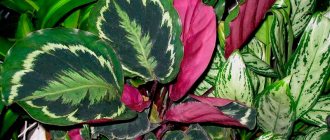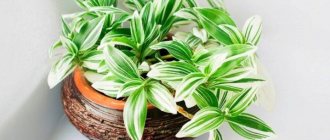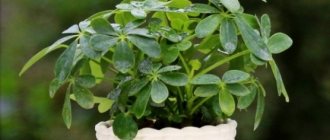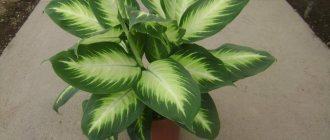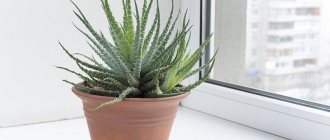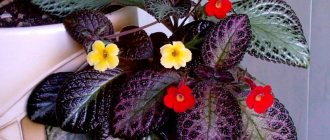Author: Elena N. Category: Houseplants Published: February 09, 2019Last edits: January 11, 2021
- Growing from seeds
- Cycas turns yellow
- Drooping cycas, or wrapped cycas, or revoluta cycas (Cycas revoluta)
Cycas, or cycad, is one of the few representatives of the most ancient flora of the planet that have survived to this day. Externally, the cicada looks like a palm tree, but it is not a palm tree. Cycad is an intermediate link between ferns and ginkgo. Growing cycads at home is a rather lengthy process. There is another difficulty: an adult plant requires a lot of space, and you must take this into account.
In our article you will find recommendations for growing cycas indoors. From it you will learn:
- what types of cycads are there;
- how does the cicada reproduce;
- how to care for a cycad;
- what problems can occur in cicada and how to deal with them.
Varieties of cycas: revoluta and its descendants
There are about 90 varieties of sago palm. However, at home, only the drooping cycas (revoluta) is usually kept, which is due to its optimal size for the interior (maximum plant height up to 1.8 m). Based on this species, 4 varieties were created, which are also suitable for home keeping.
The drooping cycas (Cycas revoluta) is a popular species to keep at home. It was he who gave rise to the popular varieties of indoor cycads
Table: cycad varieties with different leaf colors
| Variety name | Peculiarities |
| Cycas diplofoliolum (Diplofoliolum) | A distinctive feature is the lush appearance of the leaves. This is due to the fact that the leaf blades are forked, and this creates a voluminous appearance of the plant. |
| Hybrid variety Variegata | The peculiarity of the plant lies in the variegated color of its foliage. |
| Cicas Alba | Young foliage is light yellow or golden in color. The old one takes on a rich green hue. |
| Cycas corrugata | A rare variety. Its peculiarity is that the leaves have a flat color. |
Cycas breeding
Growing cycas from seed
In indoor conditions, it is very difficult to propagate cycas by seed. As a rule, this is done by experienced specialists in nurseries or greenhouses. The fact is that such a palm tree blooms extremely rarely in indoor conditions, and even if this happens, there will be no one to pollinate the flowers. If you have good seed in your hands, then before sowing it should be placed in lukewarm water for 24 hours, after which the seeds are evenly distributed over the surface of the perlite and slightly pressed into it. Place the crops in a warm place (not lower than 25 degrees). The first seedlings should appear 2-3 months after sowing. 1–2 months after the emergence of seedlings, they should have one true leaf blade fully formed. When this happens, the plants are transplanted into individual containers in a soil mixture intended for adult bushes.
Cycas from seeds
How to propagate by separating a shoot
If a plant is kept in conditions unsuitable for it, then shoots appear on its trunk. Take a very sharp knife and cut off the shoot, while trying not to injure the trunk. Cut off all the foliage from the offspring, treat the cut with a solution of a fungicidal preparation, and then with Kornevin. Then the offspring should be planted in very coarse sand or coarse perlite, after which they are watered. Be sure to treat the cut site on the mother plant; charcoal powder is used for this. During rooting, the shoots are placed in a shaded, warm (about 30 degrees) place, and care must be taken to ensure that the soil mixture is always slightly moist. The offspring should take root in 6–12 months. When this happens, it is carefully transplanted into a soil mixture intended for growing an adult cicada.
Tsikas - care at home
Caring for the Cycas revoluta at home involves timely watering, fertilizing and trimming dried leaves. If diseases and pests are detected, the bushes are sprayed with insectofungicides.
How to water correctly
Water the cicada after the top layer of soil has dried. Use soft, well-settled water. To prevent the liquid from stagnating, 15-20 minutes after watering, pour out excess water from the pan. In winter, especially when the flower is kept in cool conditions, watering is reduced.
Important! You need to water the plant in such a way that water does not fall on the foliage.
Feeding rules
From April to September, the cycas plant needs feeding. For this purpose, fertilizers intended for feeding palm trees are used. The fertilizer is diluted according to the instructions on the package. Nutrients are added to the moist soil.
Fertilizers for palm trees are used to feed cycas
At the end of autumn and winter, the cycad is not fed. The procedure is not performed immediately after transplantation and during the period when the plants are sick.
Pruning and replanting
For various reasons, leaf blades may begin to fade. You can’t cut them off right away because they continue to absorb nutrients. Remove leaves after complete drying. They are cut off at the very trunk.
Note! Pruning is done with a sharp, disinfected instrument. When a drooping cicada becomes cramped in a pot, it is transplanted
The new container should be 4-5 centimeters larger in diameter. If you choose a pot that is too large for the cycad, it will not grow until the root system entwines the container
When the drooping cicada becomes cramped in the pot, it is replanted. The new container should be 4-5 centimeters larger in diameter. If you choose a pot that is too large for the cycad, it will not grow until the root system entwines the container.
The transplant procedure is carried out as follows:
- A layer of drainage material is placed on the bottom of the container.
- A substrate consisting of peat, pine bark and river sand is poured.
- Remove the plant from the old pot along with a lump of earth.
- The roots are slightly straightened and the bush is planted in a new container.
- Water generously, and pour out excess water from the pan after 15-20 minutes.
Transfer
Due to its slow development, an adult cycas needs to be replanted once every 4-5 years. For young cycads, the diameter of the pot is increased as needed. The procedure is carried out only in early spring, before the leaf buds begin to actively unfold. They use the transfer method. After purchase, the cycas must be replanted, partially replacing the transport soil mixture.
The soil for cycas should be light, breathable, and slightly acidic. A mixture of leaf soil, high peat and sand (1:1:1) is considered optimal. Of the purchased mixtures, palm substrate is more suitable, but you will still have to add sand to it.
The pot is chosen wide and low. It is better to avoid ceramics, even glazed ones - microcracks accumulate microorganisms over time, causing fungal diseases. The size of the pot is selected so that there is 5-8 cm left from the caudex to the sides.
Cycas are handled carefully, trying to cause as little damage as possible to the fragile root system.
The transplant is carried out according to the following algorithm:
- A layer of expanded clay or pebbles, thoroughly washed in hot water, is placed at the bottom of the new container.
- Fill the pot with fresh soil and make a planting hole. Don't water.
- The cycas is removed from the old container, trying to maintain the integrity of the earthen coma.
- Place in a new pot without deepening it. If necessary, add earth to the sides and tamp lightly.
The cycad is not watered for 24 hours after transplantation, allowing the microtraumas on the roots to dry out. Otherwise, it will begin to rot. If you trim the lower leaves by 1/3 before transplanting, the cycas will quickly take root in its new location. The sections must be treated with crushed charcoal or activated carbon.
Conditions for successfully growing cycas
Priming. Cycas are not picky about the soil, but two factors must be taken into account. This is acidity - cycas prefers a slightly acidic soil reaction (pH from 6.5 to 7.0); when alkalized, nutrients cease to be absorbed. And the mechanical composition of the soil - it must be well drained, and it is not at all enough to simply pour a layer of drainage on the bottom of the pot; such drainage does not guarantee the rapid passage of water. The soil must be drained throughout its entire volume; for this, more sand or small stones should be mixed into it.
Illumination should be maximum, windows facing south are optimal. In the winter months, it is necessary to supplement the plants with phytolamps or at least fluorescent lamps (for one cycas a nearby 36-watt or more powerful energy-saving lamp will be sufficient), and a 12-14-hour daylight hours are required. With a lack of light, long and underdeveloped leaves grow, which soon turn yellow and die; they should be removed. Low light can cause growth to stop completely for several years, during which no new leaves will appear. In summer, it is useful to take the cicadas out into the garden or onto the balcony, but they must be accustomed to sunlight gradually, otherwise the leaves may get burned.
Temperature. In the summer months, the cicas prefers the heat; if there is a lack of heat, it can die from exhaustion for several years in a row. In winter, the temperature must be reduced to +12+17°C. It can withstand short-term light frosts, but the leaves may be damaged.
Watering is very important in the life of the cycas, despite its drought tolerance. When growing in a pot or container, you need to allow the soil to dry halfway deep or even almost completely, then slowly and gradually pour enough soil on top so that there is enough water for all the roots. It is useful to water the cycas twice: the first time the soil is wetted, the second time it is saturated with water after a few minutes. Excess water from the pan must be drained. The higher the light and temperature, the more often the plant will need to be watered. Do not keep the plant constantly wet; cycas does not tolerate waterlogging, but is adapted to survive during droughts. However, you should not keep the plant dry for a long time.
Fertilizers are applied from spring to autumn. The amount of fertilizer absorbed by cycas is directly dependent on the light level. Only when grown in full sun can a full dose of complex fertilizers be given (optimally NPK 3:1:3 or 3:1:2). Fertilizers must contain microelements. If the plant is at home in bright light, then it should receive half the dose of fertilizer, and in low light conditions - only a quarter. Too little fertilizer is always better than too much.
Transplantation is usually carried out in spring or summer. If the time has come for the release of new leaves, then you need to wait with replanting; during this period, the leaves are still tender, so they are easily damaged during replanting. The pot should be chosen only a little more spacious than the previous one - cycas grows better in cramped containers. It is better to give preference to tall pots.
Read more about replanting in the article Replanting indoor plants.
Pests and diseases. Cycas is a fairly strong and resistant plant, but is often damaged by mealybugs and spider mites, and can also be damaged by scale insects. Susceptible to fungal diseases if care is not followed.
Read about pest control measures in the article Pests of indoor plants and measures to control them.
General information
This plant is widespread in Australia, India and Asia. Some of its species thrive in the Caucasus and Crimea. This is one of the oldest plants on our planet. Scientists found his remains in soil layers dating back to the Permian period.
Cycas is often compared to a palm tree. This is explained by their similar appearance. In nature, the plant has a large trunk with a diameter of up to 80 cm. Its height can reach 7 m. The leaves are located at the very top of the trunk in the form of a fluffy mop.
At first glance, this is a typical palm tree, but in terms of the nucleation, pecking and opening of leaves, this plant is very similar to a fern. But Cycas revoluta is not related to ferns.
The indoor variety of cycad is a beautiful, but not without nuances, plant. Cycas revoluta sagopalm is easy to care for if you remember 2 characteristic features:
- The cycad develops slowly. Over the course of a year, its head increases by only 2 leaf blades. Therefore, you will have to be patient to get a truly beautiful plant.
- Cycas revoluta is difficult to breed. In most cases you have to buy seeds.
The indoor variety of the plant has much thinner leaves than Cycas revolute, which grows in open ground. They are attached to the central axis. First, it appears and opens at the top of the plant, and then the leaves come out. This process is slow and quite exciting.
Each leaf that appears can last for years. Thanks to this, the plant becomes more and more aesthetically attractive every year. In a pot, cycas can produce up to 15 leaves in 10 years.
The indoor cycad does not have a trunk. He hardly develops. Despite this, the height of the home bush can reach 1.5 m.
Botanists have studied ninety varieties of the sago palm. But only one species is grown at home - Cycas revoluta. Caring for this cycad is easy, and its dimensions are quite suitable for indoor growing.
Cycas revoluta has 4 varieties:
- Curled, or snail-shaped. In size it is slightly larger than the drooping cycad. It has a short trunk, at the top of which there is a rosette of 15 leaves. The leaf blades in the upper part and the area of the central vein are covered with spines.
- Tuara. This is a Madagascar variety. In nature, this cycad grows up to 10 meters in height. At home, the height of the plant rarely exceeds 1.5 m. A characteristic feature of the variety is the branched upper part and large seeds.
- Siamese cycad. This variety has a height of up to 1.8 m. A characteristic feature is very long leaves. Their length can reach 1.2 meters with a width of 20 cm.
- Tsikas Rumpha. The variety can be recognized by the emerald color of its greenery. The leaves are 1 m long. Their lobes are sparsely located. The length of each of them is 10 cm. In nature, this variety can grow up to 15 m in height.
Care
Cycads at home should be grown in very bright rooms; if a dormant period is observed, the flower can grow normally and produce new leaves with the correct structure, not elongated, hard, and looking aesthetically pleasing. Thanks to its leathery leaves covered with wax, cycas tolerates dry air well.
.
Of course, the safest place will be a very bright room, but with diffused light
.
Direct exposure to sunlight can lead to yellowing of the leaves
, and if spraying is carried out from time to time, remember that a drop of water on the leaf acts like a lens, so the plant may get
leaf burn
.
Cycas revoluta loves fresh air very much, so during the growing season and in the warm months the plant should be taken outside, to the terrace, balcony, and also to the garden. Of course, you should initially harden the flower for several days, avoiding direct sunlight. Over time, it can be taken out into the garden to a sunny place, secluded, protected from the wind.
. In such conditions, plants grow better and produce many leaves.
The cycad can spend the winter at home, but this is not the best option
.
It will be much better for the plant if it spends the winter in a well-lit room, in which the temperature will be about 10-15 ° C. It is worth noting that the plant will withstand even a short-term drop in temperature below zero
if the soil in the pot is dry, but it is better not expose the cycas to such extreme conditions, and even before the onset of frost, when the temperature is about 10 ° C, move the cycas to a place for its wintering.
If wintering at home, it is best to place the cicada on a well-lit windowsill.
Since the tsikas does not like permutations
, especially during the growth of new leaves, you must specifically decide where the cycad will be placed.
Botanical description of the plant
Cycas (cycad) unites about 90 species of cycad palms. The height of the plants reaches 15 m. Cycas revoluta or drooping cycad is the smallest variety of them. Its height in nature can reach 3 m. It lives for more than 100 years. This is an evergreen tree that is actively used in landscape design. The cycad grows very slowly, producing only one leaf per year, so it takes about 5 years to reach its maximum development. In indoor culture it grows no higher than 1 m, more often up to 0.6–0.7 m.
Did you know? Cycas are considered a status symbol throughout the world. Old and large plants collect thousands of grand prizes at international exhibitions and can generate income for their owners.
The woody type base (called caudex), which is the stem, is decorated with a cap of pendulous, feathery leaves, similar to the cap of a palm or fern. The diameter of the trunk of an adult plant reaches 20 cm. Dark green leaves grow to a length of 1 m. Sparse leaf lobes reach 10 cm and at the end taper to a pointed shape. The leaves last a very long time.
Flowers are dioecious. The female flower is cone-shaped, golden in color, the male flower is large, pineapple-colored. The female flower opens very slowly and forms a dense seed capsule after fertilization. Blooms in May. Produces large plum-shaped, pale yellow-brown seeds with a diameter of about 3 cm. They will develop throughout the summer and ripen in January-February.
| Root system | Developed |
| Stem | Cylindrical in shape, up to 20 cm in diameter |
| Leaf Shape | Long, pinnate, dark green, needle-shaped leaf segments |
| Flower shape | Cone-shaped |
| Flower color | Golden |
| Fruit shape | Cylindrical seed pod |
| Fruit color | Yellow-brown |
| Taste of fruits | Inedible |
Description of indoor cicas palm
Cycas belongs to the cycad genus, which has about 100 species. Despite this quantity, only drooping cycas can be grown indoors. It is he who often decorates apartment windows. This plant is very ancient, its ancestors were food for dinosaurs. Some novice gardeners may experience some difficulties when growing this palm tree, however, by adhering to certain care rules, these difficulties can be easily avoided.
Under natural conditions, an indoor palm tree reaches a height of more than two meters, however, when grown indoors, its height is no more than 70 cm. This plant is a slow-growing plant; per year it is capable of growing only one circle of leaves, which consist of 5-7 shoots. Small cicadas grow only one or two shoots per year, the annual growth of the trunk is about 2-3 cm. The trunk is covered with scales, the branches resemble fern leaves.
How to transplant cicas at home
Immediately after purchase, the plant needs to be transplanted from a small pot with shipping soil into a spacious container, filling it with a nutritious soil mixture. The cycad is replanted every year while it is actively growing. Having reached its maximum growth, the plant does not like to be transplanted, so they try not to disturb it further. Only once every 3-4 years will a replanting with partial replacement of the soil be required.
It is advisable to place a drainage layer at the bottom of the pot, which will protect the roots from rotting if you do not calculate the watering and excess moisture collects. Pour a little nutritious soil on top, install the plant, removed with a lump of earth, and sprinkle with earth on all sides, without deepening the root collar.
It is better to buy ready-made soil with a neutral or slightly acidic reaction. The soil should be loose, with a high content of humus.
In adult cycads, before transplanting, a third of the leaves are removed (older ones are selected) to facilitate the process of survival and restoration of roots after damage.
Home care
Care includes monitoring the climate and soil to create optimal conditions for growth. The list of activities also includes periodic feeding, pruning and replanting.
Watering
Watering is a very important event in organizing optimal conditions for the growth of cycas. Allow the top 75% of the soil to dry before thoroughly watering the cycas.
We can say that watering once every 15 days will be enough. In winter, Cycas revoluta needs moderate watering. Be careful not to pour water onto the crown of the plant. This can cause disease and possible death of the plant.
Find out what and how to feed indoor plants at home.
Top dressing
The cycad is fed monthly from spring to autumn. The fertilizer must contain nitrogen, phosphorus and potassium in a ratio of 3:1:3. If you are not sure what the plant needs, use half the amount stated on the fertilizer label. A sign of overfeeding with fertilizers is wrinkling and drying of the leaves. A sickly looking plant can also be fed with manganese sulfate. The quantity depends on the size of the cycad and should be indicated on the packaging.
Trimming
Unsightly yellow leaves are a sign of nutrient deficiency, which can be easily corrected with fertilization. Some people choose to prune their cycas by removing these yellowish leaves. But you shouldn't do that. Especially when it comes to the lower leaves. This will cause the problem to remain and move to other, healthy leaves. Even a dying leaf still absorbs nutrients and removing it slows the growth of the cypress and makes it more susceptible to infection.
Did you know? In traditional oriental medicine, cycas leaves are considered a cure for cancer and are also used in the treatment of hematomas.
Cut the leaf only when it is completely dead. Perform pruning as close to the trunk as possible. Be sure to cut off heavily damaged and diseased leaves. If desired, you can trim the flower stems and seed pods. But this weakens the Cycas revoluta and makes it more susceptible to pests.
Transfer
The roots of the cycad do not like to be disturbed, so replanting is carried out only when the plant is cramped in the old pot. It is optimal to do this once every 3 years. Transplant time is spring, before the start of the growing season.
Transplant instructions:
Choose a new pot that is 5cm larger in diameter than the previous one. Make sure there are 1-1.5 cm diameter drainage holes. Place 2-3 cm of gravel inside. Select well-drained soil for replanting. The soil may contain 1 part peat, 1 part pine bark and 1 part coarse sand
This is a completely suitable mixture for cycas. Carefully remove the plant from the existing pot. You may need to loosen it a little by sliding a shovel or knife between the edge of the soil and the sides of the pot
Once loosened, remove the cicada. Do not pull on the crown, but simply gently help it fall out. Place the plant on newspapers, loosen and straighten the lateral roots. Place some soil in the pot and place the rhizome on it so that the top layer of soil is at the same distance as it was before transplanting. Fill the space around it with fresh soil. Fill the soil thoroughly, and when the water is absorbed, add more soil until you raise it to the desired height. Drain the water that has drained from the pot into the tray.
Difficulties in growing revolutiona
If not properly cared for, the cicas may lose its decorative appearance. For example, the lower leaves may begin to turn yellow. In this case, you need to adjust the watering, adding nutrients once a month in spring and summer. Leaves should be inspected to identify diseases and harmful insects.
Diseases and pests
If the soil is over-moistened, the root system of the flower may begin to rot. To get rid of the problem, the plant needs to be removed from the pot, cut off the parts affected by rot, and spray the flower with a fungicide. After this, the cicada is transplanted into a disinfected pot with new soil.
Important! Spraying a flower with chemicals is done outdoors.
Among the pests, cycads can be attacked by scale insects and mites. To get rid of them, the plant is washed under pressure of water. If this does not help, use insecticides, for example, Karbofos or Actellik.
Cycads are treated with chemicals in the fresh air
Cycas revoluta is a capricious plant. But if agrotechnical measures are carried out correctly, the cycad can delight flower growers with its decorative appearance for many years.
Pests and diseases of cycas
Harmful insects and diseases
Of the pests, scale insects are the most dangerous for cycas, since they are protected from the action of insecticides by a waxy coating. Adults must be collected manually, and the larvae are destroyed by treating the above-ground part of the plant with contact and systemic drugs: acephate, carbaryl, pyrethrin, pyriproxyfen or other pyrethroids. Treatment is carried out in the morning or evening at temperatures below 30 ºC. Repeated treatments can be carried out at intervals of 5 to 10 days.
Cycas is affected by mealybugs, which spread throughout the plant. Collect the pests with your hands, then treat the entire plant with a preparation containing cypermethrin, not forgetting to moisten the soil in the pot with the mixture. If necessary, the treatment can be repeated after five days, the number of sprayings is up to four sessions.
If the cycas is occupied by aphids, the plant will have to be sprayed with phosphorus preparations 2-3 times at weekly intervals. And plant mites that settle in the ground part of the cycas are destroyed by triple treatment at weekly intervals with acaricidal preparations.
Among the diseases of the cycas, the most often we have to deal with are rots of the roots and caudex - the lower part of the trunk
The plant must be carefully removed from the pot, the roots must be cleared of the substrate, all blackened and darkened areas must be removed, as well as soft spots with a sharp sterile knife, the cycas should be dipped in a fungicide solution for half an hour, then all sections should be sprinkled with crushed charcoal and the plant should be allowed to dry for several hours. Then the cycas needs to be planted in a fresh sterilized substrate, after dipping its roots in a solution that accelerates the root formation process
Don’t worry if the cycas sheds all its leaves when it takes root—it makes it easier for it to survive. Worse, if rot affects the trunk from the inside, then the plant will die.
Cycas turns yellow
Most often in letters from readers there are complaints that the leaves of the cicada are turning yellow. This is a really common problem that, fortunately, can be fixed in most cases. If you don’t know what to do if the cycas turns yellow, start solving the problem by finding out the reason why the cycas turns yellow, and, as usual, there may be several reasons:
- lack of microelements;
- lack of nitrogen in the soil;
- improper lighting;
- root system injury.
In the first case, the problem may be due to the fact that you did not apply fertilizing, or it may be due to the fact that the plant is not able to absorb the applied fertilizing due to too low a temperature or due to a change in the pH value of the soil, which was caused by chronic humidification with hard water. Because of this, the roots stopped developing. If the problem is that you did not provide the plant with the necessary microelements, the problem will be solved after applying fertilizers, and the next leaves that appear on the cicada will no longer be yellow.
If the reason is a chronic violation of the conditions for keeping the cicada, the plant needs to be transplanted into new soil, and you will have to remember the rules of care. Nitrogen deficiency is eliminated by applying fertilizers containing this element, but old, yellowed leaves, alas, will no longer turn green.
As for improper lighting, here too you will have to refer to the rules for keeping the plant, because each type of cycas has its own requirements for lighting, so the leaves turn yellow not only when there is a lot of light, but in some species this happens precisely because there is little light. Sometimes the leaves of the cycas turn yellow if you take it out into the balcony or yard in the spring without first hardening it off.
The leaves of the cycas turn yellow if the plant has not been watered for a long time or, on the contrary, it has been done too often, and also if the roots of the cycas are cold or you have applied too concentrated fertilizer - the root system gives you a signal about a serious problem with yellowing leaves, and the sooner you see the signal, the easier it will be for you to fix the problem.
Cycas is drying
If the lower leaves of the cycas turn yellow and dry, then this is a natural process, and if the tips of the leaves dry out, then most likely the air in the room is too dry or you applied fertilizing in the wrong dosage. Please clarify these issues and correct any errors. Cycas is too expensive a plant to take its care lightly.
Care
Lighting
Tsikas loves light and warmth.
Even direct sunlight is not dangerous for it if there is a constant supply of fresh air. But this applies to young plants, and adults survive well in the sun even without this. In this regard, remember that lighting should be stable and regular, all year round. To ensure the crown grows symmetrically, turn the flowerpot towards the sun from one side to the other from time to time.
In winter, the lighting intensity needs to be increased: the plant is moved closer to the window and additional lighting is turned on.
Temperature
Depending on the time of year, the temperature regime for cycas is also selected. In winter it should be between +12-17 degrees, in summer – from 22 to 26 degrees. If the temperature is too high, the cycad will stop growing, and if the temperature is too low, it will begin to shed its leaves. On warm days, take the plant to an open balcony or garden, choosing a place with uniform lighting, protected from gusts of wind and rain.
Cycas does not tolerate stuffiness and heat, so ventilate the room more often and do not place the pot with the plant near heating appliances. However, do not leave it in a draft.
How to water?
The sago palm is very demanding when it comes to watering.
If the earthen ball in the pot is waterlogged, or vice versa - too dry, the plant will die. Therefore, in spring and summer, water the cycas once a week, in autumn and winter - no more than once every 10 days. Please note that the soil should dry out a little. Half an hour after watering, the water from the pan should be drained.
Wipe the leaves with a damp cloth or sponge from time to time to remove dust from your indoor plant. You can also wash it in the shower, but make sure that water does not get on the trunk - it can rot. Wrap it in film first.
Top dressing
The owner can choose a special fertilizer for palm trees, a complex fertilizer for house plants (without magnesium and calcium), or regular dried cow manure. You can, if desired, alternate them. From April to September, the palm tree needs to be fed 2 times a month; in the fall, 1 time is enough and the concentration of fertilizer decreases at this time. Apply the preparations after watering to avoid burning the roots.
How to transplant correctly?
Cycas transplantation is carried out in February-March by transferring an earthen clod. A plant under five years old is replanted once a year, an adult plant every three years.
Priming
The soil for cycads should be light, permeable, with good aeration and slightly acidic. Flower shops sell ready-made mixtures for palm trees, but you can make it yourself.
To do this, you will need the following components: turf soil (1 part), sand, humus, peat and leaf soil (2 parts each). Second option: pebbles, pumice, pine bark, peat, charcoal, peat (in equal parts) and a handful of bone meal.
Be sure to sanitize the mixture before using it in the oven or freezer.
Rest period
During the winter months, the cycad palm goes to rest. Place the pot closer to the radiator and turn on the phytolamps more often (daylight should be at least 12-14 hours).
Brief description of cultivation
- Bloom . Cycas is cultivated as an ornamental foliage plant.
- Illumination . The bush needs diffused bright light or partial shade.
- Temperature regime . During the growing season - room temperature, in winter - at least 15 degrees.
- Watering . In winter it should be scanty, and in summer it should be moderate.
- Air humidity . High - from 70 to 80 percent. Experts advise moistening the foliage with a sprayer quite often, and also its surface should be wiped with a dampened soft cloth, and the trunk should also be regularly wrapped with moistened sphagnum moss.
- Fertilizer . This fern is fed during intensive growth once every 4 weeks; for this, organic matter is used that does not include magnesium and potassium, for example, a solution of horse manure or mullein is well suited. It is not recommended to use mineral fertilizers for fertilizing.
- Rest period . It is relative, it begins in late autumn and ends in the first weeks of spring.
- Transplant . Young bushes are replanted once every 2 or 3 years. It is not recommended to replant adult ferns, but the top layer of substrate in their pot must be replaced every year. To do this, remove the top layer of soil mixture, about 50 mm thick, and then pour fresh substrate into the pot.
- Reproduction . To do this, you can use lateral shoots (if available). Only specialists can grow cycas from seeds.
- Harmful insects . Scale insects, aphids, mealybugs, spider mites.
- Diseases . Root rot, caudex rot, chlorosis.
